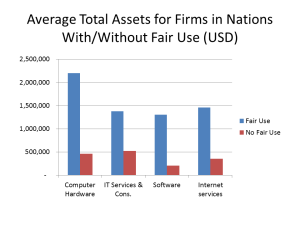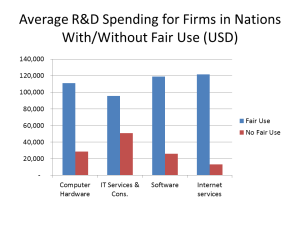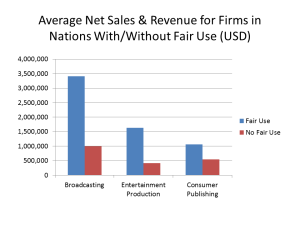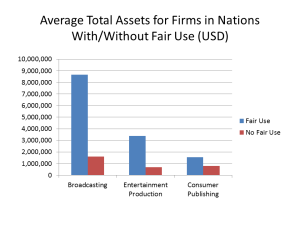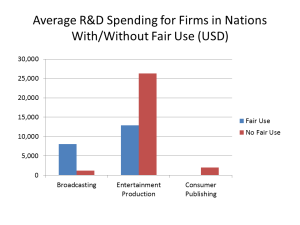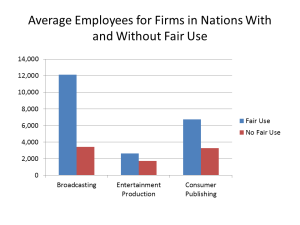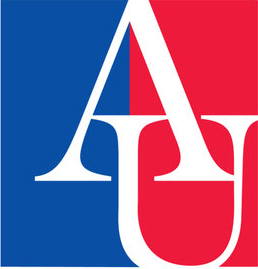 This post presents preliminary data showing that firms in industries sensitive to copyright can succeed in countries other than the U.S. when copyright limitations include fair use. It is an early product of an interdisciplinary project at American University, in which legal researchers are working with economics professor Walter Park to study how country’s copyright exceptions effect economic outcomes. The project has been undertaken as part of American University’s larger role coordinating the Global Network on Copyright User Rights. The research supports and expands on other recent research attempting to measure the value of fair use abroad.
This post presents preliminary data showing that firms in industries sensitive to copyright can succeed in countries other than the U.S. when copyright limitations include fair use. It is an early product of an interdisciplinary project at American University, in which legal researchers are working with economics professor Walter Park to study how country’s copyright exceptions effect economic outcomes. The project has been undertaken as part of American University’s larger role coordinating the Global Network on Copyright User Rights. The research supports and expands on other recent research attempting to measure the value of fair use abroad.
There is a growing consensus in the U.S. that our international trade policy needs to promote more balanced copyright laws around the world — in the sense of promoting limitations and exceptions, not just protections. This growing consensus has been expressed most recently in a U.S. Trade Representative proposal that all countries in the TPP “shall seek to achieve balance” in copyright systems. Similar principles were included in House and Senate report language for the Trade Promotion Authority bill released last week.
National law can address copyright exceptions in different ways. One way to think of the differences is in “closed” versus “open” systems of limitations and exceptions. Closed systems, found in many civil law countries, provide a restricted, itemized list of unauthorized uses of copyrighted content that are acceptable for certain purposes, but lack a catch-all exception that can be applied to uses not specifically mentioned in the closed list. Open systems also contain itemized lists of specific uses permitted by law, but add to that list a general flexible exception (often turning on a balance of interests test) that can be applied to uses not specifically mention in the list. The U.S. fair use clause is such a general exception that makes the U.S. system of limitations and exceptions “open.”
Industry Group 1
Industry Group 2 |
Proponents of open exceptions like fair use argue that they provide greater flexibility to entrepreneurs who develop new communications and ICT-related technologies. They warn that the closed systems favored by civil law countries are unable to quickly adapt to technological change, and therefore are detrimental to innovation in these sectors.
Others, however, argue that open limitations and exceptions lack the certainty of a closed list of exceptions. If companies and innovators do not know in advance whether new types of uses would be found “fair” in a potential court case, they will not take advantage of flexibilities offered by the letter of the law. At the same time, it is argued that open limitations and exceptions disincentivize creators of new content, because it is unclear they would be able to protect their rights. The question of whether countries outside of the U.S. should adopt fair use-style open clauses is regularly debated in international copyright forums, and it has been an issue in recent foreign law reform processes, including in Australia and Colombia. Opponents of fair use argue that its lack of certainty makes it “dangerous” for non-U.S. legal systems, but there no empirical work supporting this position. In fact, our initial research (which we will build upon throughout the year) indicates just the opposite. Exceptions to copyright are often thought to have different effects on different firms, depending on which industry they are in. A series of reports by Stephen Siwek identify “copyright-intensive” industries, such as publishers, movie producers and record companies, which rely the most on copyright protection.The Computer and Communications Industry Association (CCIA) has published its own reports which identify “fair use” industries, which depend upon copyright exceptions, including internet services, computer hardware, and software. The reports by Siwek and the CCIA each report value added and employment at the industry level to demonstrate the importance of each cluster of industries to the overall U.S. economy. There is overlap between the two clusters, which illustrates how many industries rely on both the strength of copyright protection and the reliability of copyright exceptions. This blog compares the experiences of firms, categorized by industry, in countries with and without open, “fair use-type” copyright exceptions in their laws. (Later releases will examine the impact other methods of creating open exceptions that do not have all the attributes of fair use). American University has constructed a dataset of data from firms from the industries that the Siwek and CCIA reports identify as sensitive to copyright and its exceptions. The dataset has 166,920 observations spread over 30 years from 5,564 firms. It represents firms from 91 countries, mostly high-income and middle-income ones. The dataset includes data from firms in each of the seven countries in the world with fair use in their copyright law – the U.S., the Philippines, Singapore, Israel, Taiwan, Malaysia, and Korea. To determine whether a firm-level observation is from a country “with fair use,” both the country and year are considered. For instance, Singapore amended its copyright law to include fair use in 2006, so observations from Singaporean firms up-to-and-including 2006 are considered without fair use, and observations from 2007 forward are considered with it. We have found that adoption of fair use clauses modeled on U.S. law is associated with positive outcomes for the firms in our dataset, both those that may be more dependent on copyright exceptions, and those that may be more dependent on copyright protection. In other words, this is not an “internet technology” vs. “big content” debate — both internet firms and content providers can benefit in fair use systems. The data for Industry Group 1 shows that firms in industries identified by the CCIA as being dependent upon copyright exceptions can thrive in countries with fair use. These are firms in our sample operating primarily in the computer hardware, IT services, software, and internet service industries. They tend – on average – to earn more money, accumulate more assets, create more jobs, and spend more on research and development, relative to countries with more closed copyright exceptions. All differences are statistically significant, with the sole exception of employment in the internet services firms. The data for Industry Group 2 shows that firms in copyright intensive firms identified by Siwek are also able to do well in countries with fair use. Firms in the consumer publishing, entertainment production, and broadcasting industries report significantly higher net sales & revenues, assets, and employees than firm in countries with closed exceptions. However, consumer publishing and entertainment firms in countries with fair use spend less on average on R&D. This is not to say that the presence of fair use in a nation’s copyright law will lead to these outcomes in all cases. However, it does seem that firms in industries affected by copyright in different ways are able to do well in countries with open exceptions. * * * As American University’s project progresses, we will gather more data in order better examine the effects of copyright exceptions on consumers and firms. We are drafting a survey of copyright experts, which will gather information on the changes to copyright law in up to 50 countries. It will include questions about the text of laws, their application by the courts, and how they are used in practice. We aim to gather information from 1990 to the present, and to use it to construct an index of the robustness of copyright user rights. Since it will cover many countries and years, it will be useful for further empirical research on copyright. In the meantime, readers may be interested in the 2015 Intellectual Property and Economic Growth Index: Measuring the Impact of Exceptions and Limitations in Copyright on Growth, Jobs and Prosperity. This work by Benjamin Gibert “examines the relationship between economic growth and intellectual property regimes in some of the world’s most innovative economies.” |


